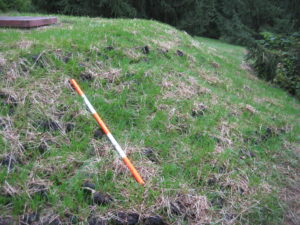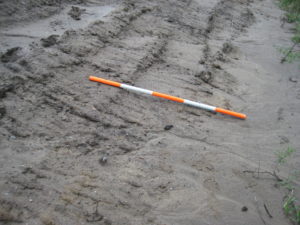Managing Construction Erosion
Every year there is a lot of construction activity in our area, assured by the growing metropolis in our midst. This results in a lot of bare dirt being exposed to erosion until something can bring it under control. Within the metropolis, places like the I-80/I-380 interchange rebuild are going to erode for years. In the county, there is a steady demand for new homes, plus repairs and upgrades of existing ones, often producing an acre or two of bare dirt. Even some conservation projects produce bare dirt for a while, building dams, ponds, wetlands, and prairie plantings, especially if it involves conversions of former crop ground, which has already lost the soil structure to help hold it together.
One way or another, the answer to prompt erosion control usually involves grass.
For large areas with steep slopes, the most efficient grass solution is often via hydroseeding in which a slurry of wood fiber, seed, a tackifier, fertilizer, and colorant is sprayed onto the bare dirt. The fiber gets glued onto the dirt, holding it in place and acting as a thin mulch, while the seeds sprout and grown up through it. This requires special equipment and is usually contracted out to a landscaping company.
At the scale of rural lots and many conservation projects, sowing a mix of grass seeds followed by a mulch of loose straw or hay is a good option. September is usually the prime month to do this because the heat and violent thunderstorms of summer are usually past, the most rapid-growing grasses are cool season grasses, and hard frost is still weeks away.
This September I added a new layer of dirt to the mound which encloses our cistern – the mound having settled at least a foot over the last thirty years. The new side slopes are steep, so there was opportunity for rapid erosion of the bare dirt. On October 1st I scattered annual ryegrass seed, which is small, but sprouts within a week or so. I also scatter perennial ryegrass seed, which will barely sprout before heavy frost arrives, but will resume growing next spring. Then I overseeded a lot of oats, which will sprout in a week with cool, moist weather, and will die by winter, but will by then have established a modest sod. The seeding was then mulched with a generous application of straw.

The dirt mound grass cover on October 10th, now hiding much of the straw layer. The orange and white intervals on the survey stick are each on foot long.

The unvegetated control site on October 10th.
The weather continued cool and rainy so watering was not necessary, and by October 10th the oats were thick and about four inches tall, with a thin understory of annual ryegrass.
A matching dirt pile a half mile away was bladed smooth in late September, and was not treated as above, serving as a control for my site. By October 10th it was beginning to develop little gullies in the bare dirt, with a layer of newly deposited mud accumulating at the base of the slope.
This demonstrates how a quick-growing grass cover can achieve good erosion control in 10 days. Winter wheat is another grain useful for early autumn erosion control, and while it starts slower than oats, it goes dormant for winter and resumes growth in spring. It will produce a crop of grain, but if left alone the birds and mice will eat most of it, leaving little to reseed.
Oats can also be planted in late March and will produce an early summer grain crop similar to winter wheat. If either are mixed into a prairie seeding for early erosion control, keep it lightweight, no more than a bushel per acre. And just mow it as needed along with the other weeds in summer.
When I was a consultant, I would advise clients to plan their earthmoving schedule to wrap it up in late August – and have the new landscape ready to seed with grasses in September. Their projects then usually looked like my first photo in this note, and we never regretted it.
Tags: construction, erosion, Lon Drake

